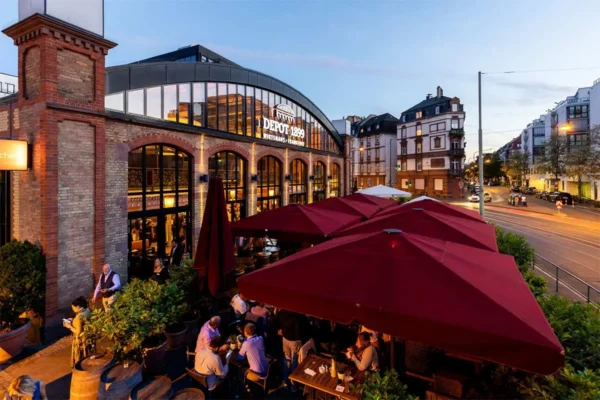You’re going to Europe for the first time and using a local stand builder. Maybe you work with them on a design; maybe you send a design over; either way, there is likely an education process that should occur. Often times, local builders assume you understand what standards are in their region, and you may assume the way we work in the U.S. is standard in Europe. Both sides shouldn’t assume, and your stand builder should help educate you on the norms and options.
There are a few key items you’ll want to consider to ensure the stand (yes, I said stand, not booth!) meets your expectations and budget.

In the U.S., we often say you can rent, own or have a hybrid of both. In Europe, it’s most common to do a build and burn or rent a system exhibit. While some companies do custom build a stand and store it in Europe, it’s just not as common. Storage pricing can be rather high due to the lack of storage space, and oftentimes, the materials used to build a storable exhibit are considerably more expensive. When deciding which build method is best for you, it’s important to consider your show schedule in Europe, storage rates, locations within Europe of your shows (how much shipping will there be) and what your budget is. If you have 10 shows, let’s say in Germany, within the year, it may be worth the expense to build and store. If you have three shows in Europe and they are all different countries, you may be better off with a build and burn or rental solution.
As in the U.S., different types of exhibits have different regulations. For example, on an inline, you’ll need to build your own walls and not rely on pipe and drape to separate you from your neighbors. On an island space, you may need to keep your hanging sign within a certain distance from all aisles. Pending your electrical and cable needs, you may be required to do a raised floor, no matter what type of space. When starting a design, make sure you consider the rules and regulations for the show.
Once you have a design that fits within regulations, deciding on the materials used for building is incredibly important. While you certainly can laminate properties in Europe, it’s not as common as painting them or using pre-fabricated laminated MDF panels. The pre-fabricated MDF is cost-effective, but doesn’t allow for much flexibility on color. If you are trying to hit a certain PMS color, painting is a great option. If the design allows for use of fabric, another cost-effective option, it allows a lot of flexibility on graphic design and the ability to hit your PMS color fairly easily.
If you decided on building and storing your stand, it’s common to have to re-touch the paint job (if you chose the paint option) every show. Don’t worry though; it’s not a large cost, and it keeps the properties looking fresh and new. It’s much harder to touch up a laminate, and it often doesn’t look as good.
Now, your exhibit is designed with the rules and regulations; you have chosen whether or not to store it and all materials are decided upon. You can’t forget about show services, however. Like the U.S., you’ll receive some sort of online, digital or paper show kit. More often than not these days, it’s online, and you’ll be provided a username and password to order your services. Your local stand builder can usually help you place these orders and sometimes pay for them on your behalf. However, unlike the U.S., it is common to find that while your stand builder can place the order, your credit card on file with the show will be the one charged. Some organizers and exhibition centers will not allow third parties to pay on your behalf. If you place and pay for the orders, make sure to send a copy of all paid items to your builder, so there are no issues onsite during build up.
Most times, onsite labor speaks limited English. If you are going to be there for build up, it’s important you request an English-speaking supervisor to help translate. This is often an extra charge. On the other hand, most organizers and exhibition centers have English-speaking personnel to help with service issues.
Another common practice is quoting installation and dismantle labor based on the job and not billing per hour as we do in the States. Unless something out of the ordinary happens, like your freight is a day late, organizers are forcing delays or you decide to make a lot of changes to the layout onsite, you’ll pay what is quoted. If the team finishes early, you won’t see a credit. If the team takes longer than expected, you often don’t see the overage charges either. Typically, there is a day rate used per person, not an hourly rate.
It is also common to see travel charges for the installation and dismantle crew. There are few labor networks throughout Europe, where you can call on them to only do labor in the local area. Most of the time the team that builds your stand also supplies in-house labor that travels with your exhibit. Therefore, if you use a German builder for a show in Spain, expect to see charges for the crew to stay overnight, travel and a per diem for food expenses. If these charges are not acceptable with you, you can inquire if they have any local labor teams instead, but usually you’ll be declined or sacrifice some labor quality.
As you can see, there are a myriad of things you need to consider when doing a show in Europe. There are even more than I can fit into this article. Make sure you have open dialogue with your local builder and/or U.S.-based exhibit house running your show. You don’t arrive surprised onsite or have your budget blown in the design process because, for example, you wanted custom laminate instead of spray paint, but didn’t understand the price difference! Europe is a great place to work (and visit), so take advantage of this unique experience and have a great show.





























